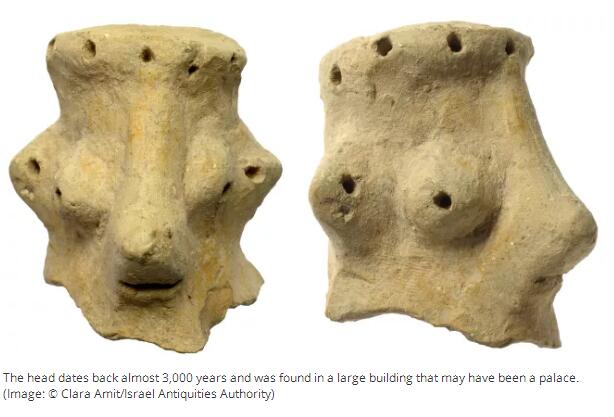Information
3,000-year-old head may be face of God
A clay head that dates back almost 3,000 years may be a rare depiction of Yahweh, — God — whose image the Israelites were forbidden from creating according to the Ten Commandments, an archaeologist reports.
But two experts in the field have denounced the idea that this head figure represents God.
Yahweh is the God of Israel; however, according to the Hebrew Bible, the ancient Israelis were forbidden from creating depictions of Yahweh, as one of the 10 commandments stated that "you shall not make for yourself an image in the form of anything in heaven above or on the earth beneath or in the waters below" (Exodus 20:4).
Archaeologists discovered the 2-inch-tall (5 centimeters) head in the ruins of a large building that may have been a palace at the site of Khirbet Qeiyafa in Israel, wrote Yosef Garfinkel, head of the Institute of Archaeology at Hebrew University who co-directs excavations at Khirbet Qeiyafa, in a recent article published in the Biblical Archaeology Review.
"Because the base of the figure's neck is well worked, the head likely was attached to another object, either a body or a pottery vessel," Garfinkel wrote.
"With a flat top, the head has protruding eyes, ears and a nose," and "because the ears are pierced, the figure may have worn earrings. Around the top of the head is a circle of holes," which may be part of a headdress, Garfinkel wrote.
Why might this be Yahweh?
Garfinkel suspects that the clay head was once part of a figurine depicting Yahweh riding a horse.
His arguments to support this idea are complex.
For one, he argues that this is the only figurine found at Khirbet Qeiyafa that dates back around 3,000 years and it was found in a building that may be a palace, suggesting that the figurine was important to the people who lived there. The time period around 3,000 years is important since it's a time period when many events in the Hebrew Bible may have taken place. For instance King Solomon, if he existed, may have lived around that time. Garfinkel believes that the people who lived at Khirbet Qeifaya at that time worshipped Yahweh.
In addition, biblical accounts tell of Yahweh riding in the skies: "For example, Psalm 68:4 reads, 'Sing to God, sing praises to his name; lift up a song to him who rides upon the clouds,'" wrote Garfinkel. He noted that there is also an important example from the Book of Habakkuk, that describes God riding a horse: ""[W]as your wrath against the rivers, O Lord? Or your anger against the rivers, or your rage against the sea, when you drove your horses, your chariots to victory?" (Habakkuk 3:8)
"Even if we were to identify the figures as depictions of gods, they could not have represented Yahweh, as he did not appear in the region before the 9th century B.C."
Though no other such figurines have been found at Khirbet Qeiyafa, similar ones — with a figure that's possibly Yahweh riding a horse — dating back nearly 3,000 years have been found in a temple and burial tombs in Israel. For instance, at the site of Tell Moza, in Israel, recent excavations uncovered two head figurines and two horse figurines within a temple, Garfinkel said. Those figurines also date back almost 3,000 years, and Garfinkel thinks those figurines originally showed two depictions of Yahweh riding a horse. The two heads are designed in a similar way to the head at Khirbet Qeiyafa, Garfinkel wrote.
Additionally, the collection of the late Moshe Dayan, an Israeli military leader, includes a vessel showing a rider on a horse, which, based on Dayan's notes, he may have looted from a burial cave in the Hebron Hills and may also date back almost 3,000 years, Garfinkel wrote in the article. Moshe Dayan was often accused of being actively involved in the looting of archaeological sites.
Garfinkel argues that these figurines were found in revered places — like a palace, temple or burial cave — because they are representations of Yahweh. For the Israelites who lived at the time, seeing a visual depiction of God was important, he said.
"As the believer sees the face of the idol, in that very moment the idol also looks at the believer. This is a metaphysical moment, a contact between earth and heaven, the core of the religious experience," Garfinkel wrote. Across the ancient Near East, it "was a common practice" for people to be able to see an image of a deity within a temple or other important place, Garfinkel wrote.
Garfinkel believes that the ban on Israelis depicting Yahweh didn't occur until later times, perhaps around the eighth century B.C., though the exact timing is not known
Live Science contacted several scholars not affiliated with Garfinkel's work to get their thoughts on the Khirbet Qeiyafa head and Garfinkel's interpretation of it.
Most were unable to reply at press time. However, Oded Lipschits, an archaeologist at Tel Aviv University who co-directs excavations at Tell Moza, and Shua Kisilevitz, an archaeologist with the Israel Antiquities Authority and Tel Aviv University who excavates at Tell Moza, denounced the idea in a jointly written response.
Category: English
News
Information
Key words:


